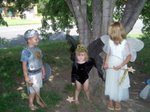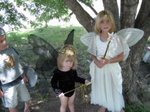 That was his view on it. Seems he only found the desert table. (I have been informed that the bowl full of goodies are Christmas cookies.) Below is a popular desert, Plumamoos. It's a fruit "soup" and can be made with fresh or dried fruit. I've also had Cherry Moos.
That was his view on it. Seems he only found the desert table. (I have been informed that the bowl full of goodies are Christmas cookies.) Below is a popular desert, Plumamoos. It's a fruit "soup" and can be made with fresh or dried fruit. I've also had Cherry Moos.
 The "dogs in a blanket" aren't ethnic but the Sweet & Sour Red Cabbage is. Not sure what is to the left. Between the two green bowls is my Gurkensalat (see Cucumber & Onion mix).
The "dogs in a blanket" aren't ethnic but the Sweet & Sour Red Cabbage is. Not sure what is to the left. Between the two green bowls is my Gurkensalat (see Cucumber & Onion mix).  The crock pot in the center holds Vereniki, it will be completely gone before anyone can get seconds. My bierocks (see KSHIPPYCHICS version) are to the top right. To the left is sausage cooked in a cabbage leaf and below it is sausage that may have been made locally.
The crock pot in the center holds Vereniki, it will be completely gone before anyone can get seconds. My bierocks (see KSHIPPYCHICS version) are to the top right. To the left is sausage cooked in a cabbage leaf and below it is sausage that may have been made locally.
 A wider shot with more sausage and cabbage some in the form of meatballs and sauerkraut.
A wider shot with more sausage and cabbage some in the form of meatballs and sauerkraut.
 After the meal we held our annual Memorial Service to honor members and family that have passed on in the past year. This year we viewed the DVD slide show that was shown at Carol Riffel's Memorial Service and listened to a beautiful rendition of Amazing Grace.
After the meal we held our annual Memorial Service to honor members and family that have passed on in the past year. This year we viewed the DVD slide show that was shown at Carol Riffel's Memorial Service and listened to a beautiful rendition of Amazing Grace.
 We seemed to run short of time, we had planned on having a couple of readings but will do them another time. Our last part of the program was to watch the video "Schmeckfest," a wonderfully informative and warmly humorous view of how ethnic foods enrich our lives.
We seemed to run short of time, we had planned on having a couple of readings but will do them another time. Our last part of the program was to watch the video "Schmeckfest," a wonderfully informative and warmly humorous view of how ethnic foods enrich our lives.
 As much as we were all enjoying the show...
As much as we were all enjoying the show...

...we had to cut it short, maybe we can schedule "Schmeckfest" for another meeting.
Edit 01/28/2008: Received an email in response for request for more information on the foods that were brought. Here's what it said...
"I brought the verenike, German sausage, zwiebach, and a Poppy Seed roll (cut into slices) - it was on dessert table. Poppy Seed roll is a Swiss Volhynian delicacy. The New Year's cookies are sometimes called "Portzilke" or "Portzeln" - both in our cookbook. There was a kuchen of Streussel Kuchen and/or Streusel Coffee Cake.
Among the meat dishes, were Cabbage Rolls (called Haluptsie in one recipe and Kalushka in another, in our cookbook), or sometimes called Pigs in a Blanket. Of course, there were Sauerkraut dishes, including the red cabbage which is a German cabbage dish. (Russian cabbage is green, German cabbage is red). Our cookbook has a red cabbage dish, called "German-style"."













7 comments:
Mmm! Looks like he knows what's important! :)
Looks like a great meeting...
Anita - That's what I thought when I first saw the picture. He sure got them framed nicely, didn't he?
Hi! I'm drooling all over the place. This is got to be better than Aussie meat pies with mashed peas and tomato sauce.
Take Care,
A Drooling Peter
He did a very good job!
OHHHHHHHHHH YUMMY! I can't wait until April - we have the feeding of the multitudes with a huge german buffet. I love love love love verinika and sausage so much!
Next January you should come to our Folklore meeting, you could fix up a big batch of bierocks! : )
I'll admit to bringing the New Year's Cookies to the ethnic meal. In case anyone is interested in knowing how I make them, here is the recipe:
New Year’s Cookies
(Raisin Fritters)
“Niejoasch Küake” or “Portselkje”
2 C. raisins (plumped)
½ C. sweet cream
¼ C. butter
2 eggs (beaten)
½ t. vanilla
1 C. potato water
1 T. sugar
2 T. active dry yeast
3 C. flour (plus about 1 C. extra flour, the amount will depend on the size of eggs and humidity on the day you are making these fritters)
¼ C. sugar
2 t. salt
1 t. baking powder
½ t. nutmeg
sugar for coating
Plump raisins by pouring boiling water over them and allow to soften for 10-15 minutes; drain. Scald cream; add butter and cool to lukewarm; add beaten eggs and vanilla. Dissolve 1 T. sugar in warm potato water and add yeast to activate. Sift 3 C. flour and the other dry ingredients together. Place cream mixture, yeast mixture and dry ingredients in a mixing bowl and stir to combine. Finish by kneading in the extra flour and raisins to make a soft dough. (If using a bread machine, place cream mixture, dry mixture and yeast mixture in bread pan and allow to mix on the dough cycle, adding additional flour until the dough pulls away from the sides of the pan. When the machine mixing has ended, carefully add raisins and mix thoroughly throughout the dough—otherwise the mixing paddle will beat the raisins to pieces. It works best to take the dough out of the pan and knead the raisins in by hand. One can also do this in the bread machine pan using a rubber spatula. Mixing a small amount of flour with the raisins will help keep them in the dough so they won’t fall out.) Allow to rise until double in bulk. Pinch off small balls of dough and place on baking sheet. When they have raised again fry in deep, hot fat until golden brown (about 2—3 minutes per side). Some recipes call for less flour, resulting in a batter rather than dough. After the batter has raised, it is dropped by spoonfuls into the hot fat with the result being a football-shaped pastry. Remove fritters from hot fat and cool. Before serving, place several fritters at a time in a sack with sugar and shake to coat evenly.
The cultural connection:
Dutch Mennonites moving to the Vistula River delta (in present day Poland) in the 16th century most likely brought with them a tradition of serving fried cakes or fritters on New Year’s Day. The Dutch version was called Oliebollen (oh-lee-bow-len) or Oliekoeks (literally oil balls or oil cakes) because they were fried in oil. Cakes and pastries fried in deep fat are still eaten in some northern European countries to celebrate the New Year. They are a symbol of affluence and luxury. Fried pastries carried with them the wish for a prosperous, fat (abundant) New Year.
The Low German speaking Mennonites carried the tradition to Russia in the late 18th and early 19th centuries. In Low German they are called Portselkje (port-zell-kya). When the spongy yeast batter or dough is dropped by spoonsful into hot, deep fat, the dough puffs up, tumbles over and fries to a golden brown. “Portsel” in Low German means tumbling over. Hence the name, “Portselkje”.
The ingredients of New Year’s Cookies are symbolic of a prosperous and happy New Year:
Flour & potato water = the necessities of life
Cream, butter and frying oil = abundance, luxury
Sugar = sweetness
Eggs = reproduction, prosperity
Yeast & baking powder = growth
Salt = a preserving and savoring quality
Vanilla & nutmeg = a flavorful and spicy life
Raisins = fruitfulness
The recipe is from my Mama.
Cultural connection/history from “Mennonite Foods & Folkways from South Russia, volume 1”
by Norma (Jost) Voth.
Post a Comment